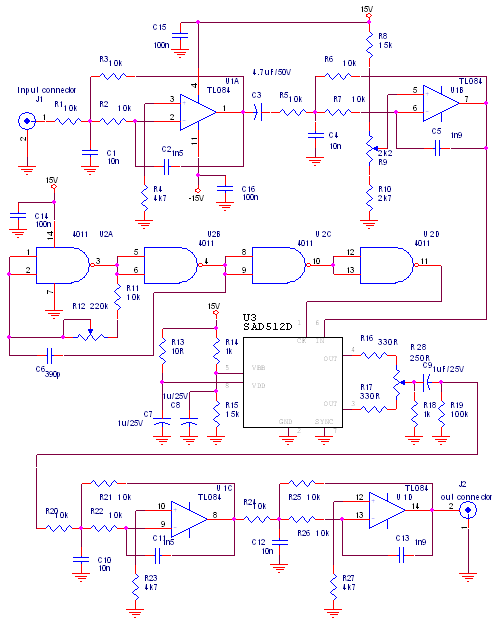Analog Effects
A bit complicated...
http://electronics4everyone.blogspot.com/2009/07/analog-audio-delay-line3d-sound.html
On the radio today every song has some sort of delay/reverb combination. The pop genre tends to almost overuse the effects which has led the genre to a computer generated sound. Timed delays (or echoes) are used to make instruments sound like they are larger than life and are playing in a certain space. To make an analog delay there is a lot that we have to do. Even in this very complex looking circuit, an IC (integrated circuit) chip is used to do the majority of the work. I won't attempt to explain the internals of the IC SAD512D, which is the square in the center, but I will say that it is controlled by a timer and an input audio signal. The input signal must be the mixed left and right since there is no circuitry to deal with stereo signals. In the circuit shown there is a fourth order active low pass filter to roll of the high end at 24 db per octave. The corner frequency is set at 2.5 kHz. The output of the delay is then sent to a two stage power amplifier to get the signal where it needs to be for speaker play back. This circuit is really cool, but somewhat unrealistic for audio applications. First off, the signal will always roll off the high end. This may not work with what we are trying to do in a song. Also, the amount of time we can delay the signal is somewhat limited. This type of delay was used when audio mixing first began, but today it is considered somewhat obsolete. To create an analog reverb we have to take a somewhat mechanical aproach. There really is no circuit that can replicate all of the reflections that come from a room (which is what reverb is), so some old reverbs actually recreated a very small version of a room using plates. This type of reverb is called plate reverb and is emulated by digital systems still today.
Digital Effects
http://www.soundonsound.com/sos/sep07/articles/insidetrack_0907.htm
Digital systems have a huge advantage when it comes to effects. Every aspect in a digital system is changable so that one unit can do everything we need. However, most units are limited in that they can only operate on one track at a time. If we are using stand alone units (usually called outboard gear) we can send multiple tracks to a single unit by using "aux sends" on the mixing board, if the board has aux sends. For example, lets say a board has 4 aux sends available. This means that every channel will have 4 knobs labeled "Aux 1", "Aux 2", etc. If we wanted to send 4 tracks to a reverb unit we could rotate the "Aux 1" knob on each track, and then send the mixed "Aux 1" signal to input of the delay unit. Every Aux send has a correspoding return, so that we would send the output of our delay to the return channel. We could then turn the volume up or down on the return channel until it sounded right. We also could simulate this process in one of our mixing programs. In the program we would send the signal to a plugin which would do whatever we wanted to the signal and we would mix that signal back over the original. Generally with effects such as delay and reverb we keep the original dry signal and just mix the altered signal over the top of it.
Sources
- Electrical Engineering. Principles and Applications
One of my textbooks in my EE class - one of my main references for this page. - Electric Circuits
Amazing EE Textbook that thouroughly explains filters and op-amps - Audio Circuits
This site explains some basic audio amplifier circuits - Free Circuit Diagram
I used this diagram of a basic compressor to illustrate a basic compressor circuit - Alectronics
Website with comprehendable/buildable audio circuits - Electroschematics
This site has tons of electric diagrams that have explanations of how they work
